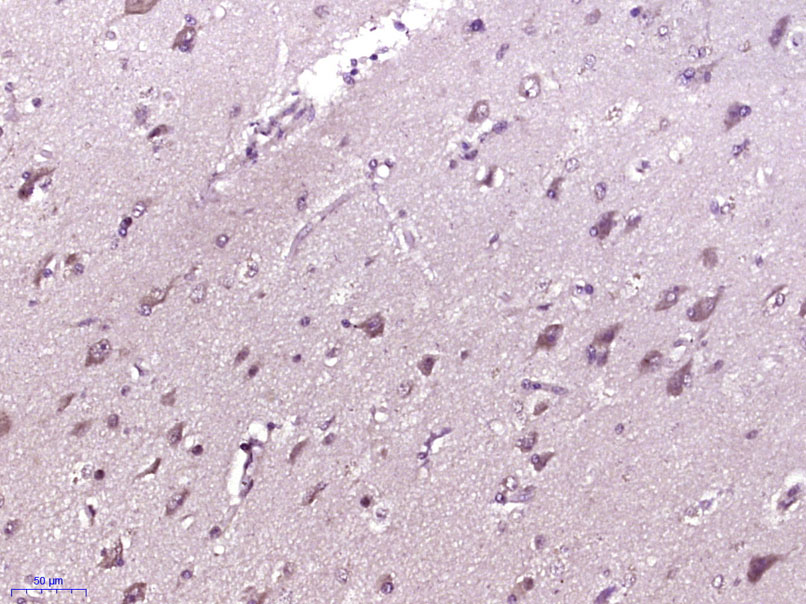PISD Rabbit pAb
PISD Rabbit pAb
- 产品详情
- 实验流程
- 背景知识
Application
| IHC-P, IHC-F, IF |
|---|---|
| Primary Accession | Q9UG56 |
| Reactivity | Human, Mouse |
| Predicted | Rat, Chicken, Dog, Pig, Horse, Rabbit |
| Host | Rabbit |
| Clonality | Polyclonal |
| Calculated MW | 46672 Da |
| Physical State | Liquid |
| Immunogen | KLH conjugated synthetic peptide derived from human PISD |
| Epitope Specificity | 151-250/409 |
| Isotype | IgG |
| Purity | affinity purified by Protein A |
| Buffer | 0.01M TBS (pH7.4) with 1% BSA, 0.02% Proclin300 and 50% Glycerol. |
| SUBCELLULAR LOCATION | Mitochondrion. |
| SIMILARITY | Belongs to the phosphatidylserine decarboxylase family. |
| SUBUNIT | Heterodimer |
| Important Note | This product as supplied is intended for research use only, not for use in human, therapeutic or diagnostic applications. |
| Background Descriptions | Enzymes known as phosphatidylserine decarboxylases (PSDs) catalyze the formation of phosphatidylethanolamine from phosphatidylserine via phosphatidylserine decarboxylation. Type I PSDs contain LGST motifs and are found in bacteria and eukaryotic mitochondria, whereas type II PSDs contain GGST motifs and are found in eukaryotic endomembrane systems. PISD (phosphatidylserine decarboxylase), also known as phosphatidylserine decarboxylase proenzyme, PSDC, PSD, PSSC, DJ858B16, dJ858B16.2 or DKFZp566G2246, is a 408 amino acid a type I phosphatidylserine decarboxylase that localizes to the inner mitochondrial membrane. PISD contains a conserved LGST motif which is cleaved to produce two isoforms known as PISD α and PISD β. PISD is capable of forming a heterodimer and is highly expressed in liver and testis. The gene encoding PISD maps to human chromosome 22q12.2. |
| Gene ID | 23761 |
|---|---|
| Other Names | Phosphatidylserine decarboxylase proenzyme, mitochondrial {ECO:0000255|HAMAP-Rule:MF_03208}, 4.1.1.65 {ECO:0000255|HAMAP-Rule:MF_03208, ECO:0000269|PubMed:30858161}, Phosphatidylserine decarboxylase beta chain {ECO:0000255|HAMAP-Rule:MF_03208}, Phosphatidylserine decarboxylase alpha chain {ECO:0000255|HAMAP-Rule:MF_03208}, PISD {ECO:0000255|HAMAP-Rule:MF_03208} |
| Dilution | IHC-P=1:100-500,IHC-F=1:100-500,IF=1:100-500 |
| Storage | Store at -20 °C for one year. Avoid repeated freeze/thaw cycles. When reconstituted in sterile pH 7.4 0.01M PBS or diluent of antibody the antibody is stable for at least two weeks at 2-4 °C. |
| Name | PISD {ECO:0000255|HAMAP-Rule:MF_03208} |
|---|---|
| Function | Catalyzes the formation of phosphatidylethanolamine (PtdEtn) from phosphatidylserine (PtdSer) (PubMed:30488656, PubMed:30858161). Plays a central role in phospholipid metabolism and in the interorganelle trafficking of phosphatidylserine. May be involved in lipid droplet biogenesis at the endoplasmic reticulum membrane (By similarity). |
| Cellular Location | [Phosphatidylserine decarboxylase beta chain]: Mitochondrion inner membrane {ECO:0000255|HAMAP-Rule:MF_03208, ECO:0000305|PubMed:30858161, ECO:0000305|PubMed:33718843}; Single-pass membrane protein {ECO:0000255|HAMAP-Rule:MF_03208}; Intermembrane side {ECO:0000255|HAMAP-Rule:MF_03208} [Isoform 1]: Mitochondrion inner membrane |
For Research Use Only. Not For Use In Diagnostic Procedures.
Provided below are standard protocols that you may find useful for product applications.
BACKGROUND
Enzymes known as phosphatidylserine decarboxylases (PSDs) catalyze the formation of phosphatidylethanolamine from phosphatidylserine via phosphatidylserine decarboxylation. Type I PSDs contain LGST motifs and are found in bacteria and eukaryotic mitochondria, whereas type II PSDs contain GGST motifs and are found in eukaryotic endomembrane systems. PISD (phosphatidylserine decarboxylase), also known as phosphatidylserine decarboxylase proenzyme, PSDC, PSD, PSSC, DJ858B16, dJ858B16.2 or DKFZp566G2246, is a 408 amino acid a type I phosphatidylserine decarboxylase that localizes to the inner mitochondrial membrane. PISD contains a conserved LGST motif which is cleaved to produce two isoforms known as PISD α and PISD β. PISD is capable of forming a heterodimer and is highly expressed in liver and testis. The gene encoding PISD maps to human chromosome 22q12.2.
终于等到您。ABCEPTA(百远生物)抗体产品。
点击下方“我要评价 ”按钮提交您的反馈信息,您的反馈和评价是我们最宝贵的财富之一,
我们将在1-3个工作日内处理您的反馈信息。
如有疑问,联系:0512-88856768 tech-china@abcepta.com.























 癌症的基本特征包括细胞增殖、血管生成、迁移、凋亡逃避机制和细胞永生等。找到癌症发生过程中这些通路的关键标记物和对应的抗体用于检测至关重要。
癌症的基本特征包括细胞增殖、血管生成、迁移、凋亡逃避机制和细胞永生等。找到癌症发生过程中这些通路的关键标记物和对应的抗体用于检测至关重要。 为您推荐一个泛素化位点预测神器——泛素化分析工具,可以为您的蛋白的泛素化位点作出预测和评分。
为您推荐一个泛素化位点预测神器——泛素化分析工具,可以为您的蛋白的泛素化位点作出预测和评分。 细胞自噬受体图形绘图工具为你的蛋白的细胞受体结合位点作出预测和评分,识别结合到自噬通路中的蛋白是非常重要的,便于让我们理解自噬在正常生理、病理过程中的作用,如发育、细胞分化、神经退化性疾病、压力条件下、感染和癌症。
细胞自噬受体图形绘图工具为你的蛋白的细胞受体结合位点作出预测和评分,识别结合到自噬通路中的蛋白是非常重要的,便于让我们理解自噬在正常生理、病理过程中的作用,如发育、细胞分化、神经退化性疾病、压力条件下、感染和癌症。






